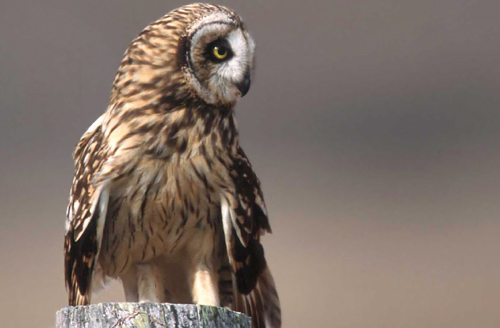| Kingdom: Animalia Phylum: Chordata Class: Aves (Birds) Order: Strigiformes Family: Strigidae | ||
 Short-eared Owl (Asio flammeus)
Identification: Short-eared Owls are so named for the erect but barely visible ear tufts atop their heads. As the most aerial of all owls, this tawny-colored owl can be mistaken for the Northern Harrier at a distance. At 38 cm, these owls are medium-sized, with long, narrow wings. Tawny overall, they are spotted above and boldly streaked below, although streaking fades on the paler belly. Dark eye-patches offset the large golden eyes that adorn their broad facial disks. In flight, their outstretched wings expose the buffy patches above and black wrist-marks below. Their easy, wavering flight is characterized by stiff, erratic wingbeats and is very moth-like in appearance. Calls: Silent except in the nesting season, the male Short-eared Owl gives a muffled "poo, poo, poo" in short series. When alarmed, both sexes bark out high, raspy, nasal notes "cheef, cheef, cheewaay." Nests: Short-eared Owl nests beginning in April on the ground in a small depression excavated by the female and sometimes in ground burrows. Females select the nest site and only sparsely line it (if at all) with grasses, weeds and occasionally feathers. Often concealed by low vegetation, the nest is safe haven for the 4-14, 39 mm, creamy white, unmarked eggs of the clutch. The number of eggs laid is said to be dependant on the abundance of rodents. While the female alone incubates the clutch for 25-28 days, the male feeds her during this time. Young birds hatch asynchronously producing variously sized siblings in the nest. Both parents rear the young birds and fledging occurs in 31-36 days post-hatching. Food: Although Short-eared Owls predominantly hunt small mammals, they also consume small birds and insects. These owls hunt at dusk and dawn and may hunt communally when prey is abundant. The primary feathers of their wings are modified to eliminate the noise of airflow, creating virtually silent flight for hunting. Soaring low over open country, these owls swoop down from the air or their perches (hawking) to snatch-up their victims with their sharp talons. |
| |
 birding.in
birding.in
| Birds | Bird Diagram | Ornithology | Indian Sites | Bird Watching | Migration | North India | Birds of India | Haryana |
All rights reserved. Copyright © 2005-2013 Birds and birding in India. Disclaimer
website: Free Java Guide & Tutorials